Abstract
Coffee flavor is profoundly influenced by numerous factors, including the origin’s terroir and variety, as well as post-harvest processing, drying, and sorting. Even specialty coffee beans, carefully selected for their high quality, can exhibit a wide range of flavor profiles depending on how they are roasted and ground. Traditionally, the coffee industry has used the Brewing Control Chart, which considers total dissolved solids (TDS) and extraction (E), to guide professionals toward achieving consistent flavors. However, this chart has limitations in representing the complex chemical composition and its influence on the sensory attributes of coffee. This study explores a more comprehensive approach to evaluating coffee quality by utilizing a taste sensing system (electronic tongue) to measure acidity and bitterness for full-immersion brewing. We investigate the impact of brew ratio and grind size on these taste attributes, while also considering the influence of roast level. Our findings demonstrate that finer grind sizes significantly affect TDS and E, while roast level and grind size significantly affect sensory attributes, as measured by the taste sensing system. This approach complements the traditional Brewing Control Chart by providing a more nuanced understanding of how roast level and grind size influence coffee flavor.
1. Introduction
Coffee flavor is a complex sensory experience shaped by a multitude of factors, starting from the origin’s terroir and variety to post-harvest processing, drying, and sorting [1,2]. The Specialty Coffee Association (SCA) has established rigorous grading criteria for specialty coffee (SP) green beans, distinguishing them from commercial coffee (CO) based on factors like defect count and sensory evaluation scores [3]. However, even with high-quality SP, the final flavor of the brewed coffee is significantly influenced by roasting and grinding parameters, including roast level, grind size, brew ratio, time, and temperature [4,5]. These factors impact the composition and concentration of soluble compounds extracted from the beans, ultimately defining the beverage’s sensory profile.
Traditionally, the coffee industry has relied on the Brewing Control Chart (Figure 1 left), developed in the 1950s, as a guide for achieving consistent and desirable flavors [6]. This chart uses TDS and E (Equation (1)) as indicators of extraction strength, visually representing the relationship between these parameters and aiming to help coffee professionals consistently hit target TDS and E values that are believed to correspond to desirable flavor profiles. While this chart has served as a valuable tool, recent research has highlighted its limitations in capturing the full complexity of coffee flavor, particularly as it relates to roast level.
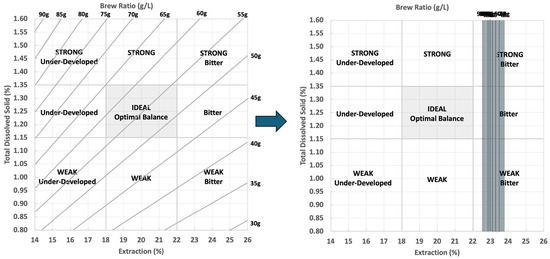
Figure 1.
The Brewing Control Chart in the (left) figure visually represents the relationship between total dissolved solids (TDS) and extraction (E) in brewed coffee, with diagonal lines indicating different brew ratios. This chart is commonly used by the coffee industry to guide professionals in achieving consistent and desirable flavors. In the equilibrium state of full-immersion brews, E becomes nearly constant regardless of the brew ratio and converges to the gray region, as shown in the (right) figure. It was created based on Liang’s report [7].
Studies by Liang et al. [7] and Frost et al. [8] have pointed out that the Brewing Control Chart does not differentiate between the various compounds extracted from coffee beans, focusing only on the total amount of dissolved solids. This oversimplification obscures the intricate relationship between TDS, E, and the diverse array of sensory attributes present in coffee, especially the influence of roast level on the generation of specific taste compounds. According to Liang et al., the equilibrium E in full-immersion brewing converges to a nearly constant value [7]. This can be schematically represented as the state in Figure 1 (left) transitioning to the state in Figure 1 (right) at equilibrium (cf. Supplementary Figure S1).
Furthermore, the chart’s division into discrete zones suggests that minor variations in TDS or E lead to abrupt changes in sensory quality. This simplification fails to acknowledge the continuous nature of taste perception and the nuanced interplay between flavor attributes [8]. While a new Brewing Control Chart has been proposed by SCA that adds bitterness intensity based on sensory evaluation to the classic Brewing Control Chart [9], in reality, the sensory experience of coffee is a gradual transition influenced by a multitude of factors beyond TDS and E.
Recognizing these limitations, this study presents a novel approach to coffee evaluation using a taste sensing system (electronic tongue) to quantify acidity and bitterness for full-immersion brewing. Electronic tongues employ advanced sensor technology to mimic human taste perception, offering a more comprehensive and objective means of assessing specific taste attributes than traditional methods like the Brewing Control Chart [10,11,12,13].
This study investigates the impact of brew ratio and grind size on acidity and bitterness, while also accounting for the crucial factor of roast level, which is not reflected in TDS and E. By utilizing the taste sensing system, we aim to provide a more nuanced understanding of how these variables contribute to the complex flavor profile of coffee.
2. Materials and Methods
2.1. Coffee Bean Data
The study used SP beans from the Heights Farm in Karatu, Tanzania (altitude 1600 m), harvested in the 2023–2024 crop season. The beans, a blend of Bourbon, N39, and KP423 varieties, underwent traditional washed processing, ensuring a clean cup profile with consistent flavor characteristics. This particular coffee was chosen for its desirable sensory profile, characterized by citrus acidity and a well-balanced body, which corresponds to approximately 83 points in the SCA sensory evaluation. The beans were imported to Japan in January 2024 and stored in a temperature-controlled warehouse (around 15 °C) to maintain their quality and freshness.
2.2. Roasting Data
Roasting was conducted by an experienced roaster using a Fuji Royal 1 kg roaster (Fuji Royal, Osaka, Japan). A total of 300 g of green coffee beans were roasted to four clear levels: light, medium, city, and French, encompassing a range of roast degrees commonly encountered at coffee consumption. The specific roasting stop point for each roast level was determined based on visual cues, such as the onset of the first and second crack, ensuring distinct differences in roast degree while maintaining consistency within each level. The roasted beans were immediately sealed in valve-fitted aluminum packaging to preserve freshness and prevent oxidation, and then stored at −18 °C until further processing.
Table 1 summarizes the key parameters for each roast level, including the roasting stop point based on visual cues, the total roasting time, and the yield. The L* value, representing the lightness of the ground beans, was measured using a colorimeter (Nippon Denshoku SA4000, Bunkyo, Japan), providing a quantitative measure of roast degree.

Table 1.
Roasting parameters and properties of four roast levels of specialty coffee beans from the Heights Farm, Karatu, Tanzania. The L* value, a measure of lightness, provides a quantitative indication of roast degree, with lower values corresponding to darker roasts.
2.3. Grinding and Extraction Samples
The four roast levels of coffee beans were ground using a Fuji Royal R440 mill (Fuji Royal, Osaka, Japan) at four grind size settings (1.5, 3, 4.5, and 6), corresponding to median particle sizes of 600, 796, 1055, and 1400 µm, respectively, based on manufacturer data. This resulted in 16 unique combinations of roast level and grind size, allowing for comprehensive assessment of their impact on extraction and taste attributes.
Following grinding, 8 g of each ground coffee sample was placed in a 200 mL beaker. Then, 150 mL of 93 °C water was added, stirred three times, and immersed for 4 min. This grind size, temperature, and extraction time were selected based on SCA cupping protocol guidelines and to ensure consistent extraction conditions across all samples [4,6]. The extracted coffee was then filtered through a conical dripper with a paper filter, and 50 mL of the filtrate was used as the sample for taste sensor analysis. TDS was measured with PAL-COFFEE (BX/TDS) (Atago, Minato, Japan) and E was calculated according to Equation (1).
2.4. Taste Sensing System/Electronic Tongue
Taste evaluations were performed using the commercial Taste Sensing System TS-5000Z (Intelligent Sensor Technology, Atsugi, Japan) [10,14]. This system uses advanced sensor technology to mimic human taste perception, enabling the objective quantification of specific taste qualities. The TS-5000Z consists of a reference electrode and a set of sensor electrodes connected to a detection unit. The internal solution of both the reference and sensor electrodes is a mixture of 3.33 M KCl and saturated AgCl [10]. This study focused on acidity and bitterness using the specialized sensor electrodes CA0 and C00, respectively.
Measurement involves a series of steps to ensure accurate and reliable taste quantification. First, the detection unit is immersed in a reference solution (30 mM KCl, 0.3 mM tartaric acid) to obtain a baseline measurement of electrical potential (Vr). This reference solution corresponds to human saliva, providing a neutral point of comparison for taste intensity [10]. Subsequently, the sensor electrodes are immersed in the sample coffee solution to measure the sample potential (Vs). The difference between Vs and Vr (Vs–Vr) represents the response value, correlating directly to the intensity of the specific measured taste attribute.
After each measurement, the membrane surface of the sensor electrodes is carefully washed with a cleaning solution to remove any adsorbed substances from the previous sample. This cleaning step ensures accurate measurement of subsequent samples. This entire measurement procedure is repeated four times for each sample, and data from the 2nd to 4th measurements are used for analysis, minimizing variability and enhancing the reliability of the results. Finally, the estimated intensity of taste (EIT) in acidity and bitterness are calculated using specific formulas developed for acidity and bitterness (Equations (2) and (3)), where 1 unit represents a 20% difference in concentration [10,11,15,16]. This standardized approach allows for a quantitative and comparative assessment of taste attributes between coffee samples.
3. Results and Discussion
3.1. Influence of Grind Size and Roast Level on TDS and E
Table 1 shows the measured TDS and E values for each of the 16 coffee samples, representing various combinations of roast level and grind size. Figure 2 visualizes the relationship between TDS and E, demonstrating a consistent trend where finer grind sizes yield higher TDS values across all roast levels. This is attributed to the increased surface area of finely ground coffee, facilitating a greater extraction of soluble components [5]. E exhibits a similar trend because it is calculated using TDS (Equation (1)).
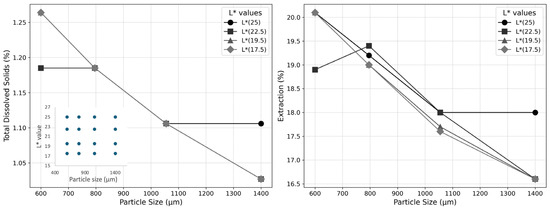
Figure 2.
The relationship between total dissolved solids (TDS) and extraction (E) for 16 coffee samples prepared with different grind sizes and roast levels. Each data point represents a unique combination of roast level (L* value) and grind size setting (corresponding to median particle size). The inset graph shows the distribution of L* values and grind sizes used in this study.
However, the left inset in Figure 2 shows that, despite the distinct L* values representing different roasting degrees, TDS does not effectively reflect the variations in roast levels across the four roast levels. This observation aligns with Liang et al.’s findings [7] and highlights a key limitation of using TDS and E as sole indicators of coffee quality because they fail to distinguish between the various compounds extracted from the coffee beans. While roast level significantly affects the chemical composition of coffee, affecting its sensory characteristics [17], TDS and E only quantify the total amount of dissolved solids without differentiating between the different compounds responsible for specific tastes, such as those associated with acidity and bitterness.
Figure 3 further emphasizes this point by plotting the 16 extracted coffee samples on the traditional Brewing Control Chart. While the data points exhibit a clear trend of increasing values with finer grind sizes, the roast level information is not reflected. This confirms that—especially at full-immersion brewing—different roast levels can result in very similar TDS and E values [7], making it challenging to evaluate the impact of roasting on sensory characteristics solely based on this chart.
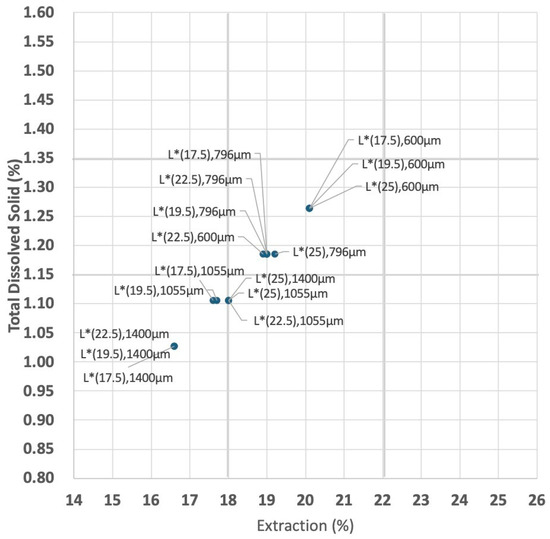
Figure 3.
The positioning of the 16 extracted coffee samples on the Brewing Control Chart, highlighting the lack of distinction between different roast levels despite variations in grind size.
3.2. Quantifying Acidity and Bitterness: The Role of Roast Level and Grind Size
Figure 4 and Figure 5 show the EITacidity and EITbitterness values, respectively, obtained from the TS-5000Z, plotted against both grind size and L* values (roast level) as contour maps. The values were normalized to the sample with an L* value of 25 and a median grind size of 600 µm for easier comparison (cf. Supplementary Table S1). These maps provide a visual representation of the combined effect of grind size and roast level on these two key taste attributes.
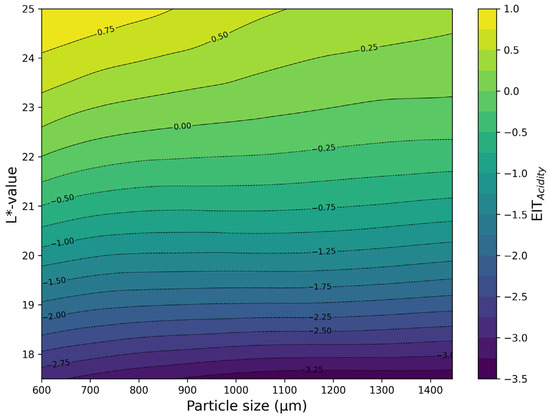
Figure 4.
A contour map depicting the relationship between the estimated intensity of acidity (EITacidity), roast level (L* value), and grind size at full-immersion brewing. The non-parallel contour lines indicate a non-linear relationship between these variables and acidity, with grind size exerting a stronger influence at lighter roast levels.
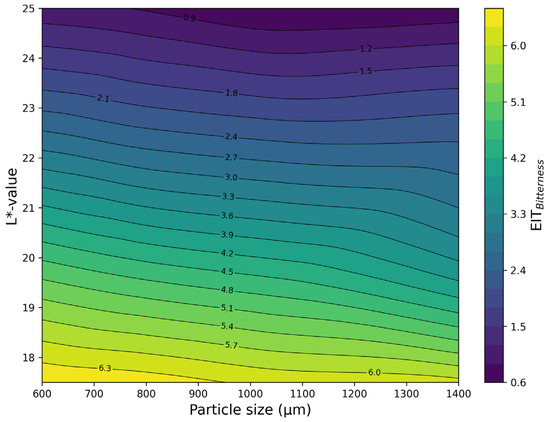
Figure 5.
A contour map illustrating the relationship between the estimated intensity of bitterness (EITbitterness), roast level (L* value), and grind size at full-immersion brewing. The non-parallel contour lines suggest a more pronounced impact of grind size on bitterness at darker roast levels.
Consistent with the observed trends in TDS and E, both contour maps generally show that EITacidity and EITbitterness increase with decreasing grind size. This observation further confirms that a finer grind size results in a greater extraction of compounds associated with these taste attributes, supporting the role of increased surface area in facilitating higher extraction yields [8].
However, the more crucial observation lies in the clear impact of roast level on both acidity and bitterness. Figure 4 shows that EITacidity values steadily decrease as roast level deepens (lower L* value). Conversely, Figure 5 shows that EITbitterness values exhibit the opposite trend, increasing with darker roasts. This finding aligns with established sensory trends reported in studies using both electronic tongues and human sensory panels [11,14,18] and is explained by the chemical transformations occurring during roasting [13,17,19]. As roasting progresses, organic acids responsible for acidity break down, while the formation of bitter compounds like caffeoylquinic acid lactones (CQL) and vinyl catechol oligomers (VCO) increases [13,20,21]. The TS-5000Z effectively captures these roast-dependent variations in acidity and bitterness, providing objective evidence for the impact of roasting on these crucial taste attributes.
Interestingly, the contour lines in both maps are not parallel to the x-axis. In Figure 4, the non-parallel contour lines in the upper-right region (representing lighter roasts and finer grind sizes) suggest a stronger influence of grind size on acidity at lighter roast levels. This could be due to the higher concentration of extractable acidic compounds present in lighter roasts. Similarly, in Figure 5, the non-parallel contour lines in the lower-left region (representing darker roasts and finer grind sizes) indicate a more pronounced impact of grind size on bitterness at these roast levels. This is consistent with Andueza et al.’s assertion that too fine a particle size results in a bitter or over-extracted taste [22]. This observation may be attributed to the combined effect of the increased extraction of bitter compounds formed during roasting and the increased fragility of darker roasts [23], making them more susceptible to variations in particle size distribution during grinding.
These contour maps highlight the complex, often non-linear, relationship between roast level, grind size, and taste attributes at full-immersion brewing. They offer a more comprehensive and nuanced understanding compared to the simplified discrete zones of the traditional Brewing Control Chart, empowering coffee professionals to better control acidity and bitterness by fine-tuning their roasting and grinding based on the desired flavor profile.
4. Conclusions
This study confirms and expands upon previous research highlighting the limitations of relying solely on the traditional Brewing Control Chart for evaluating coffee quality. While TDS and E serve as useful indicators of overall extraction strength, they do not capture the nuances of coffee flavor, particularly the impact of roast level and grind size on acidity and bitterness, because TDS and E only measure the total amount of dissolved solids without considering the varying contributions of different compounds extracted from the coffee beans.
By using a taste sensing system (TS-5000Z), we demonstrated the significant influence of roast level and grind size on the EITacidity and EITbitterness of coffee. With its ability to objectively quantify specific taste attributes, the TS-5000Z offers a more comprehensive and nuanced approach to coffee evaluation, complementing the traditional Brewing Control Chart and enabling a deeper understanding of the factors influencing coffee flavor.
The contour maps generated from the taste sensor data visualize the continuous relationship between roast level, grind size, and taste perception, moving beyond the oversimplified discrete zones of the traditional Brewing Control Chart. This enhanced understanding empowers coffee professionals to fine-tune their roasting and brewing practices, achieving greater control over flavor and delivering a more consistent and satisfying coffee experience for consumers.
Ultimately, this study highlights the importance of incorporating objective analytical methods for taste evaluation, alongside existing sensory methodologies. The SCA’s Coffee Value Assessment sheet [4], for example, aims to address this need by expanding the scope of evaluation to encompass a wider range of taste attributes, including umami and saltiness, along with aroma. Furthermore, considering the established standards set by organizations like the Coffee Quality Institute (with their Q-grader certification) and the Cup of Excellence program, developing objective and common analytical indicators for coffee flavor is crucial for a comprehensive and standardized assessment across the industry.
Future research building upon this study will investigate the correlation between other taste attributes measured by the TS-5000Z and human sensory evaluations, as well as the impact of extraction time on taste, supported by chemical analysis. This aims to develop a robust model for objective taste evaluation, contributing to a more comprehensive and standardized assessment of coffee flavor across the industry.
Supplementary Materials
The following supporting information can be downloaded at https://www.mdpi.com/article/10.3390/chemosensors12090196/s1, Figure S1: factors affecting TDS and E; Figure S2: acidity and bitterness values vs. grind size; Figure S3: acidity and bitterness values vs. roast level; Table S1: raw acidity and bitterness values from taste sensing system.
Author Contributions
Conceptualization, T.H.; methodology, T.H.; validation, T.H. and M.H.; formal analysis, M.H.; data curation, M.H.; writing—original draft preparation, T.H.; writing—review and editing, T.H. and M.H.; visualization, M.H. All authors have read and agreed to the published version of the manuscript.
Funding
This study was funded by both companies and no external fund were used.
Institutional Review Board Statement
Not applicable.
Informed Consent Statement
Not applicable.
Data Availability Statement
The original contribution presented in the study are included in the article/Supplementary Materials, further inquiries can be directed to the corresponding authors.
Conflicts of Interest
The authors declare that the research was conducted in the absence of any commercial or financial relationships that could be construed as a potential conflict of interest.
References
- Sunarharum, W.B.; Williams, D.J.; Smyth, H.E. Complexity of Coffee Flavor: A Compositional and Sensory Perspective. Food Res. Int. 2014, 62, 315–325. [Google Scholar] [CrossRef]
- Spencer, M.; Sage, E.; Velez, M.; Guinard, J. Using Single Free Sorting and Multivariate Exploratory Methods to Design a New Coffee Taster’s Flavor Wheel. J. Food Sci. 2016, 81, S2997–S3005. [Google Scholar] [CrossRef] [PubMed]
- Fernández-Alduenda, M.; Ionescu, K.E.; Giuliano, P.; Rugolo, J.; Delrue, R.; Apostolopoulos, Y. A System to Assess Coffee Value; Specialty Coffee Association: Irvine, CA, USA, 2024. [Google Scholar]
- Coffee Value Assessment. Available online: https://sca.coffee/value-assessment (accessed on 16 July 2024).
- Cordoba, N.; Fernandez-Alduenda, M.; Moreno, F.L.; Ruiz, Y. Coffee Extraction: A Review of Parameters and Their Influence on the Physicochemical Characteristics and Flavour of Coffee Brews. Trends Food Sci. Technol. 2020, 96, 45–60. [Google Scholar] [CrossRef]
- Lingle, T.R. The Coffee Brewing Handbook; Specialty Coffee Association of America: Irvine, CA, USA, 2011. [Google Scholar]
- Liang, J.; Chan, K.C.; Ristenpart, W.D. An Equilibrium Desorption Model for the Strength and Extraction Yield of Full Immersion Brewed Coffee. Sci. Rep. 2021, 11, 6904. [Google Scholar] [CrossRef] [PubMed]
- Frost, S.C.; Ristenpart, W.D.; Guinard, J. Effects of Brew Strength, Brew Yield, and Roast on the Sensory Quality of Drip Brewed Coffee. J. Food Sci. 2020, 85, 2530–2543. [Google Scholar] [CrossRef] [PubMed]
- Towards a New Brewing Chart|25, Issue 13. Available online: https://sca.coffee/sca-news/25/issue-13/towards-a-new-brewing-chart (accessed on 17 September 2024).
- Kobayashi, Y.; Habara, M.; Ikezazki, H.; Chen, R.; Naito, Y.; Toko, K. Advanced Taste Sensors Based on Artificial Lipids with Global Selectivity to Basic Taste Qualities and High Correlation to Sensory Scores. Sensors 2010, 10, 3411–3443. [Google Scholar] [CrossRef] [PubMed]
- Toko, K.; Tahara, Y.; Habara, M.; Ikezaki, H. Potentiometric Electronic Tongue Using Lipid/Polymer Membrane. In Electronic Tongues: Fundamentals and Recent Advances (IOP Series in Sensors and Sensor Systems); Shimizu, F.M., Braunger, M.L., Riul, A., Jr., Eds.; IOP Publishing: Bristol, UK, 2021; pp. 2-1–2-26. [Google Scholar]
- Bhumiratana, N.; Adhikari, K.; Chambers, E. Evolution of Sensory Aroma Attributes from Coffee Beans to Brewed Coffee. LWT—Food Sci. Technol. 2011, 44, 2185–2192. [Google Scholar] [CrossRef]
- Baggenstoss, J.; Poisson, L.; Kaegi, R.; Perren, R.; Escher, F. Coffee Roasting and Aroma Formation: Application of Different Time−Temperature Conditions. J. Agric. Food Chem. 2008, 56, 5836–5846. [Google Scholar] [CrossRef] [PubMed]
- The Sixth Sense. Global Coffee Report January/February 2021, 12 January 2021; 40–41.
- Toko, K.; Tahara, Y.; Habara, M.; Kobayashi, Y.; Ikezaki, H. Taste Sensor: Electronic tongue with Global selectivity. In Essentials of Machine Olfaction and Taste; Nakamoto, T., Ed.; Wiley: Singapore, 2016; pp. 87–174. ISBN 978-1-118-76848-8. [Google Scholar]
- Hayashi, N.; Chen, R.; Ikezaki, H.; Yamaguchi, S.; Maruyama, D.; Yamaguchi, Y.; Ujihara, T.; Kohata, K. Techniques for Universal Evaluation of Astringency of Green Tea Infusion by the Use of a Taste Sensor System. Biosci. Biotechnol. Biochem. 2006, 70, 626–631. [Google Scholar] [CrossRef] [PubMed]
- Kobayashi, Y.; Ikezaki, H. Advanced Taste Sensors Based on Artificial Lipid Membrane. In Biochemical Sensors, Mimicking Gustatery and Olfactory Senses; Toko, K., Ed.; Jenny Stanford Publishing: Singapore, 2013; pp. 5–44. [Google Scholar]
- Ishiwaki, T.; Ikezaki, H. Application of Taste Sensor to Blending of Coffee. In Biochemical Sensors, Mimicking Gustatery and Olfactory Senses; Toko, K., Ed.; Jenny Stanford Publishing: Singapore, 2013; pp. 83–90. [Google Scholar]
- Taguchi, M.; Tanbe, Y. Equation for Taste of Coffee; NHK Publishing: Tokyo, Japan, 2014; pp. 162–163. ISBN 978-4-14-033282-5. [Google Scholar]
- Frank, O.; Blumberg, S.; Kunert, C.; Zehentbauer, G.; Hofmann, T. Structure Determination and Sensory Analysis of Bitter-Tasting 4-Vinylcatechol Oligomers and Their Identification in Roasted Coffee by Means of LC-MS/MS. J. Agric. Food Chem. 2007, 55, 1945–1954. [Google Scholar] [CrossRef] [PubMed]
- Frank, O.; Zehentbauer, G.; Hofmann, T. Bioresponse-Guided Decomposition of Roast Coffee Beverage and Identification of Key Bitter Taste Compounds. Eur. Food Res. Technol. 2006, 222, 492–508. [Google Scholar] [CrossRef]
- Andueza, S.; de Peña, M.P.; Cid, C. Chemical and Sensorial Characteristics of Espresso Coffee as Affected by Grinding and Torrefacto Roast. J. Agric. Food Chem. 2003, 51, 7034–7039. [Google Scholar] [CrossRef] [PubMed]
- Kornman, C.; Becker, E. An Evaluation of Consistency, Cupping Settings, and the Impact of Roast Degree. Roast Magazine May/June 2021, 2021; 46–67. [Google Scholar]
Disclaimer/Publisher’s Note: The statements, opinions and data contained in all publications are solely those of the individual author(s) and contributor(s) and not of MDPI and/or the editor(s). MDPI and/or the editor(s) disclaim responsibility for any injury to people or property resulting from any ideas, methods, instructions or products referred to in the content. |
© 2024 by the authors. Licensee MDPI, Basel, Switzerland. This article is an open access article distributed under the terms and conditions of the Creative Commons Attribution (CC BY) license (https://creativecommons.org/licenses/by/4.0/).